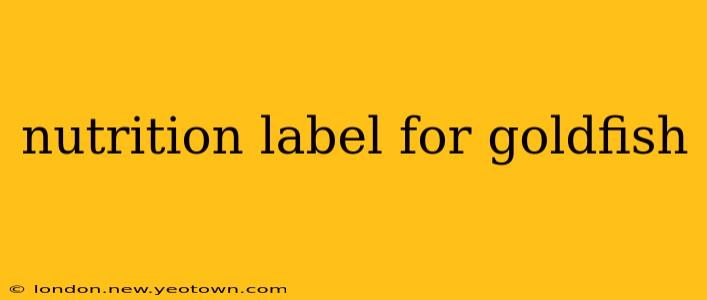Decoding the Tiny Text: Understanding Goldfish Food Nutrition Labels
Let's be honest, staring at a tiny goldfish food label feels a bit like deciphering hieroglyphics. Those minuscule numbers and percentages can be confusing, especially when you want the best for your finned friend. But understanding what's in that food is crucial for your goldfish's health and happiness. This isn't just about feeding them; it's about providing the nutrients they need to thrive. Think of it as translating the secret language of fish food!
My journey into the world of goldfish nutrition started with a simple question: what exactly is in that tiny pellet? This led me down a rabbit hole of ingredient lists, percentage breakdowns, and a surprising amount of scientific terminology. But I'm here to share what I learned, making the process of choosing goldfish food a little less daunting.
What are the Key Ingredients to Look For?
The first thing to remember is that goldfish are omnivores, meaning they eat both plants and animals. A balanced diet is key to their overall well-being. A good quality goldfish food will reflect this with a mix of ingredients.
You'll often see ingredients like fish meal and krill meal prominently featured. These are excellent sources of protein, essential for muscle growth and overall health. Look for foods that specify the type of fish meal, as some sources are higher quality than others. Spirulina, a type of blue-green algae, is also beneficial, providing essential vitamins and minerals.
On the other hand, ingredients like wheat flour or corn gluten meal are fillers. While not inherently harmful in small quantities, too much filler means less nutritional value per pellet. A food high in fillers might leave your goldfish feeling hungry and potentially lead to nutritional deficiencies.
What About Protein and Fat Percentages?
What percentage of protein should goldfish food contain? This is a common question, and the answer isn't a single number. Generally, a protein percentage between 30-40% is considered good for adult goldfish. However, young, growing goldfish might benefit from a slightly higher percentage. Remember to always check the feeding instructions based on your fish's age and size.
How much fat is too much? Fat is necessary for energy and healthy skin and scales, but too much can lead to obesity and other health problems. Look for a fat percentage around 5-10%. High-fat foods are usually less desirable unless explicitly stated for specific needs, such as during breeding or recovery from illness.
What are the common additives in goldfish food?
Many goldfish foods contain added vitamins and minerals to supplement the natural ingredients. These are generally beneficial, but always look for a reputable brand that clearly lists the added vitamins and their amounts. Avoid foods with excessive artificial colors or preservatives.
How do I choose the right size of food for my goldfish?
How do I know what size of food pellet to buy for my fish? This depends entirely on the size of your goldfish! Smaller pellets are ideal for smaller fish, preventing them from choking or struggling to eat. Larger goldfish can handle larger pellets, but always monitor your fish for any signs of difficulty eating. Uneaten food should be removed promptly to prevent water quality issues.
Are there specific nutritional needs for different types of goldfish?
Are there different nutritional requirements for different breeds of goldfish? While the basic nutritional needs remain similar across goldfish breeds, some might have slightly different requirements depending on their size, activity level, and age. For example, larger, more active goldfish might need a slightly higher protein intake. Always research the specific needs of your goldfish breed if you have a less common variety.
Choosing the right goldfish food is a significant step in ensuring your little friend lives a long and healthy life. By understanding the information on the nutrition label, you empower yourself to make informed decisions about their diet. Remember, a balanced and nutritious diet is the foundation of a happy and vibrant goldfish.

